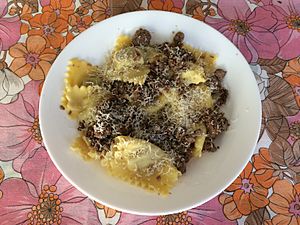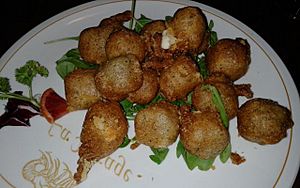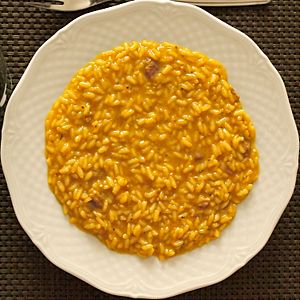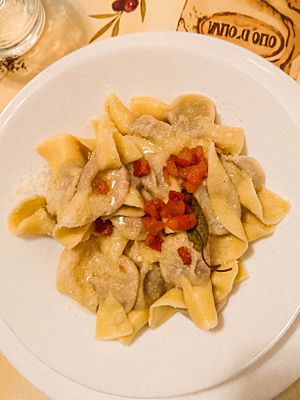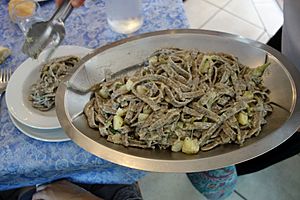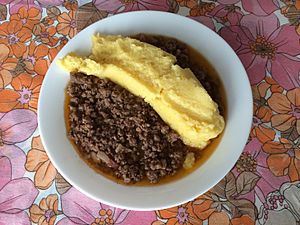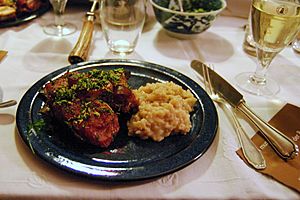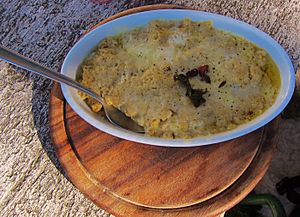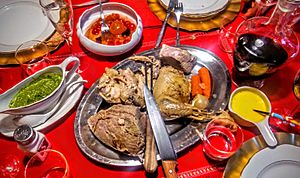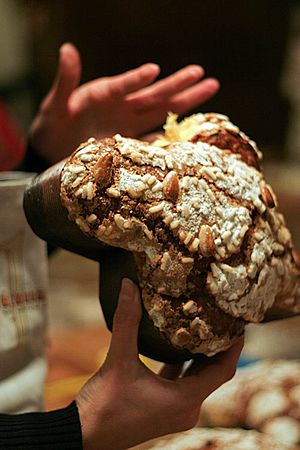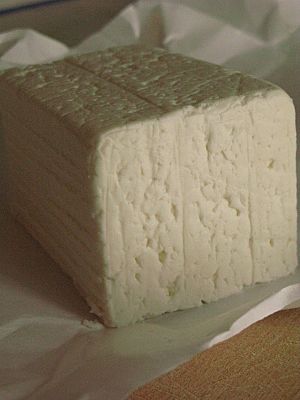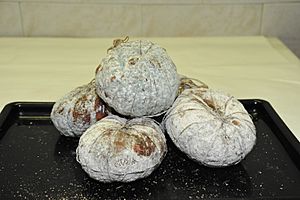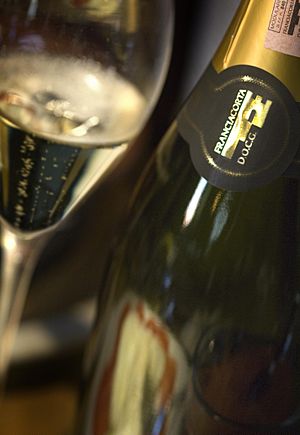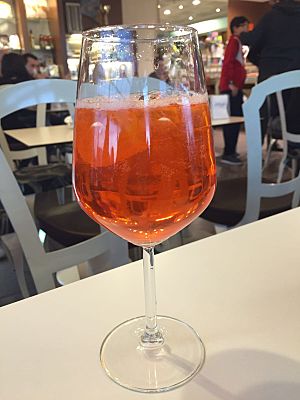Lombard cuisine facts for kids
Lombard cuisine is a type of cooking from the northern part of Italy, specifically the region of Lombardy. This area has a very rich and diverse food tradition because of its long history and different landscapes. You'll find everything from delicious risottos to hearty soups and stuffed pasta. There are also many meat dishes and fresh fish dishes from the region's many lakes and rivers.
What makes Lombard cuisine special? People here often eat rice and stuffed pasta more than dry pasta. They also use butter for cooking instead of olive oil. Many dishes are cooked slowly for a long time. You'll find lots of pork, milk, and dairy products (like cheese), plus dishes made with eggs. And just like in other parts of Northern Italy, polenta (a dish made from cornmeal) is very popular.
Contents
A Taste of History
Lombard cooking has a very old past, going back to when the Celts lived in the Po Valley. One of the oldest Lombard dishes is cuz, a lamb dish from Val Camonica, which has Celtic roots.
Over time, Lombardy's cooking was shaped by different rulers. These included the Romans, the Duchy of Milan, the Duchy of Mantua, the Austrians, the Spanish, and the French. Even the Republic of Venice influenced the food in areas like Bergamo and Brescia. All these influences helped create the varied cuisine we see today.
What Makes Lombard Food Special?
Lombardy is a big region with lots of different areas and a long history. Because of this, it's hard to say there's just one "Lombard cuisine." Instead, it's more like a collection of different provincial cuisines that share some things in common.
One of the most unique things is how much rice and stuffed pasta are used. Rice is super important! You can find simple rice soups, rice with meat or vegetables, and fancy risotto dishes. When cooking risotto, people often use butter or even lard instead of oil. This is because Lombardy makes a lot of milk and dairy products – about 40% of all milk in Italy! It also has a huge variety of cheeses. Many recipes also use eggs (like omelettes), pork, and polenta, which are common across the Po Valley.
Many traditional Lombard dishes are cooked slowly over low heat. Think of braised meats, stews, and boiled meats. This cooking style came from a time when there was plenty of firewood for long cooking.
You can also see differences in food based on where you are in Lombardy. In the flat areas where rice grows, risotto and plain vegetables are common. As you get closer to the Alps, you'll find more dishes with game (wild animals hunted for food) or farm animals, plus potatoes and cabbage. Near the lakes, you'll find risotto and stews made with freshwater fish. They even produce olive oil there, with two special kinds: Garda and Laghi Lombardi.
The history of each province also plays a role. Food in eastern Lombardy might be similar to Venetian food. Western Lombardy shares traits with Piedmontese food, with lots of braised meats and stews. Southern Lombardy is like Emilian food, with many stuffed pasta dishes. And Valtellina's food is similar to Alpine cuisine, using game, salami, and cheese a lot.
Popular Dishes
Appetizers
The most common appetizers in Lombardy are cured meats and cheeses. These are often eaten as main courses too, sometimes with polenta.
A popular appetizer is sciatt valtellinesi. These are crispy buckwheat pancakes filled with cheese that melts when cooked in butter.
First Courses
Rice Dishes
Rice is a key ingredient in all Lombardy's local cuisines, from Valtellina to Mantovano. Lombardy produces 42% of all Italian rice! A basic rice dish is rice in cagnone, which is boiled rice seasoned with butter, garlic, and sage, then topped with Grana cheese. It can also be served with asparagus or pumpkin. You'll also find rice soups with vegetables like cabbage, turnip, and peas.
The most famous first courses are risotti. These are made by toasting rice and then cooking it slowly with hot broth. Common risotto types across Lombardy include mushroom and sausage risotto.
Two very famous risotto dishes are Risotto alla Milanese, which gets its yellow color from saffron, and risotto alla pilota, which is typical of the Mantua area. Near the lakes, you can find fish risottos, like risotto with perch from Lake Como or with tench from Lake Garda.
Stuffed Pasta

A common stuffed pasta dish is ravioli di magro. These ravioli are usually filled with egg yolk, ricotta cheese, and different herbs depending on the area. Sometimes, in the past, people even used wild herbs like dandelion or nettles when food was scarce.
In the eastern provinces, you'll find casoncelli (also called casonsei). These stuffed pastas come in different shapes and are filled with meat, grana cheese, and herbs. They are usually served with butter and cheese. From Cremona province, there are marubini in broth, which are square and filled with braised meat, salami, Grana Padano cheese, and nutmeg.
In Mantua, you can try tortelli di zucca (pumpkin tortelli), which also include apple mostarda (a sweet and spicy fruit preserve) and amaretto cookies. The tortelli cremaschi from Cremona are very unique, filled with amaretti, raisins, mint, candied citron, mostaccino cookies, and lemon peel, along with breadcrumbs and nutmeg.
From Pavia province, especially Oltrepò Pavese, come agnolotti.
Other Pasta Types
One of the most famous dry pasta dishes is pizzoccheri della Valtellina. These are thick tagliatelle made from buckwheat flour and served with potatoes, savoy cabbage, and melted cheese. In Mantua, you might find bigoli con sardelle, which are bigoli pasta cooked with sardines. In the Garda area of Brescia, there are bardele coi marai, or borage tagliatelle, usually served with butter.
Dishes similar to gnocchi include pumpkin gnocchi and pizzoccheri from Valchiavenna (small potato gnocchi with butter and melted cheese). From Bergamo, there are strangolapreti, made from stale bread, eggs, milk, and herbs.
Soups
A well-known soup made from Lombardy's farm products is minestrone alla milanese. It's made by boiling the main vegetables grown in the region and flavored with lard and pork rinds. Other simple, traditional soups include zuppa alla pavese, a soup with broth, stale bread, eggs, and grated cheese. pancotto is stale bread soaked in water and cooked with butter and meat. In Brianza, you can find urgiada, a barley soup with bacon, leeks, and beans.
Main Courses
Lombardy's main dishes are mostly meat-based. However, near the lakes and big rivers like the Po or Ticino, you'll find many fish dishes.
Meat Dishes
Sausage, especially pork sausage, is very popular throughout the region. Another common dish is bollito misto (mixed boiled meats), which uses different cuts of meat and is served with mostarda (a sweet and spicy fruit preserve) from Cremona or Mantua. cotechino (a large pork sausage) is also widely eaten, sometimes with bollito misto.
From Milan and western Lombardy, you'll find cassoeula, a stew with pork ribs, sausage, and cabbage. You can also find rosticciata (rustisciada), a dish of sausage and pork shoulder with onions. Bruscitti, from Altomilanese, is a braised meat dish cut very thin and cooked in wine and fennel seeds. A classic Milanese dish is ossobuco (marrowbone).
In Bergamo and Brescia, polenta e osei is famous. This dish features birds like thrushes or larks browned in butter or on a spit, served with polenta. In Mantua, beef and donkey stews are common.
In the Alpine area of Valtellina, you can try pork ribs al lavècc, where marinated pork ribs are cooked for hours with wine in special soapstone pots. Also, pork alla pioda involves cooking different cuts of pork on a stone slab, often with vegetables like potatoes and eggplants. In the mountains of Lecco, Bergamo, Sondrio, and Brescia, you'll find stews and ragouts made from Alpine animals like roe deer, deer, and hares, often served with polenta.
Veal meat is very popular in Milan and is used in two famous city dishes: cotoletta alla milanese (breaded veal cutlet) and ossobuco. Ossobuco is traditionally served as a single dish with risotto, seasoned with parsley, garlic, and lemon zest. Goose meat is widely eaten in Pavia and Lomellina for first and second courses, and sausages.
Fish Dishes

The most famous fish dish from Lake Como is missoltini. These are salted and dried agoni (a type of fish) that are then grilled and often eaten with toasted polenta and red wine. Other dishes from Lake Como include lavarello or alborelle, which can be fried or prepared in carpione (marinated).
On Lake Garda, famous dishes include trout baked with mushrooms and Gardesana eel, which is grilled and seasoned with oil and lemon. In the past, eel was also cooked near rivers. On the Mantuan banks of the Po, fried fish and pike in sauce are typical. Freshwater fish dishes can also be found in the Pavia area and western Lombardy.
Vegetarian Dishes
Common vegetables in the Lombard plain include celery, beans, green beans, carrots, leek, zucchini, eggplant, pumpkin, tomato, spinach, and asparagus. Potatoes and savoy cabbage can grow even in colder mountain areas.
Vegetarian main courses include various kinds of stuffed vegetables, especially zucchini, savoy cabbage meatballs, and asparagus Milanese style (boiled and served on a fried egg). Chard parmigiana is also popular. People used to make omelettes with fine herbs like mint, chives, parsley, and chervil.
Polenta
In the past, polenta was a main food for Lombard people. It could be eaten alone or as a side dish with meat, vegetables (like mushrooms), or with lard (for pulenta e gras pestà), or with one of the many cheeses. There are many ways to prepare and season polenta:
- Polenta taragna: Typical of Valtellina and the Alpine areas of Bergamo and Brescia. Buckwheat flour is added to the corn flour, making the polenta darker than the usual yellow.
- Polenta uncia: From the Como area. Cheese and butter (with sautéed garlic and sage) are added while the polenta is still hot.
- Polenta cròpa: Typical of upper Valtellina, cooked with cream.
- Pult: From Lecco, made with wheat flour added to corn flour.
- Tóch: From the Como area, similar to polenta uncia, but the cheese and butter are added to the polenta after it's served, not melted inside the pot.
Polenta and corn flour leftovers could also be used to make sweets, like the Mantuan fiapòn.
Sides, Sauces, and Seasonings
A classic side for boiled meat is mostarda. It also goes well with strong cheeses. The most common types are Cremona mostarda (with cherries, tangerines, peaches, and pears in a syrup with mustard oil), Voghera mostarda (similar but less spicy), and Mantuan mostarda (with pears, apples, quince, pumpkin, and melon). Mostarda di cipolle (onion mustard) is also popular; it's more like a jam but still has mustard essence.
To go with mixed boiled meat, there's peverata (made with capers, anchovies, garlic, and hot pepper), horseradish sauce (with horseradish and vinegar), and grattacù sauce (with rosehip berries, wine, and sugar). The Milanese yellow sauce is made with egg yolk and lemon juice, heated until it sets.
Other sauces, some shared with other parts of Northern Italy, include green sauce (or "bagnetto verde"), made of parsley, oil, and anchovies (in Lombardy, stale bread and egg yolk are also added). Red sauce is made by cooking tomatoes, peppers, and carrots.
Desserts
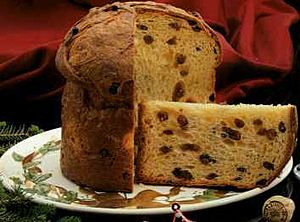
The most famous Lombard sweets are panettone and colomba, both from Milan. Panettone is a cylindrical Christmas cake with raisins and candied fruit, now popular all over Italy. Colomba is usually eaten at Easter; it has a similar dough to panettone but is shaped like a dove and covered with icing and sugar. Another Milanese Christmas sweet, especially for New Year's Eve, is carsenza, made with raisins and apples.
A fancier version, between panettone and brioche, is veneziana. It's covered with icing and sugar grains. The large version is eaten at Christmas, but smaller, doughnut-sized portions are eaten year-round. Other Christmas sweets outside Milan include bisciola valtellinese, a bread loaf similar to panettone with raisins, and bossolà bresciano, which is made with three rounds of rising dough.
frittelle (fritters) are popular throughout Lombardy, with different names based on ingredients and preparation. Common types are chestnut frittelle (made with chestnut flour) and apple frittelle (with apple filling).
Other famous regional sweets include Cremona nougat (turòon), said to have been created for a wedding in the 15th century. amaretti di Saronno are crispy cookies made from almonds, egg white, and armelline. Baci di Cremona are similar to baci di dama but have a crispy hazelnut flour cookie. Baci del Signore di Pavia are flatter, filled with orange marmalade, and partly covered in chocolate.
Other cookies include offelle di Parona (sometimes made with rice flour), mostaccini (a Cremonese cookie with spices like clove, mace, coriander, and star anise), and biscottini di Prosto (a buttery cookie from Valchiavenna baked twice).
In the low plains, there are several famous cakes: the Mantuan torta delle rose (rose cake), Anello di Monaco (a tall, iced doughnut), and sbrisolona cake (a crumbly cake made with yellow flour and almonds). The similar Lodi cake tortionata uses white flour.
From Cremona, there's spongarda, a cake filled with dried fruit, and torta bertolina, made with strawberry grapes. Torta del Paradiso is from Pavia. A sweet version of the Bergamo dish polenta e osei is made with sweet polenta covered with yellow almond paste and decorated with chocolate birds or marzipan.
In western Lombardy, you'll find brutti e buoni from Gavirate (almond and hazelnut sweets), chiaro di Luna from Paullo, and torta paesana from Brianza (made with cocoa, milk, and stale bread to reuse leftovers). Made with corn flour are Amor polenta from Varese and pan meino (Pan de mej), a small sweet focaccia flavored with elder flowers.
Special Products
Lombardy has a huge number of special food products with protected names (like PDO and PGI). As of January 2019, there were 34 of these: 14 cheeses, 10 types of sausages and salami, 4 fruits and vegetables, 2 fish, 2 olive oils, and 1 honey. The region also has 250 products recognized by the Ministry of Agriculture.
Cheese
Lombardy is famous for its dairy products. It has 14 cheeses with special European Union protection (D.O.P.) and 63 with Italian traditional product status (P.A.T.), which is the highest number in Italy.
One of the most famous cheeses is Grana Padano. It's produced in most of the region and is a very old, hard Italian cheese. It's used to top first courses and in fillings, just like Parmigiano Reggiano (which is made in the province of Mantua). Both come from an even older cheese called Granone Lodigiano, which monks at the Chiaravalle Abbey might have created in the 12th century.
Another famous Lombard cheese is Gorgonzola, originally from Milan. It comes in two types: a "sweet" one that's soft and creamy, and a "spicy" one that's firmer and has a stronger taste. Other popular cheeses include Taleggio, a soft cheese from the Taleggio valley, and Quartirolo Lombardo. The newest protected cheese is Silter from Brescia.
From the mountain areas, especially Valtellina, come Casera and Bitto. These cheeses can be eaten alone or melted over pizzoccheri or in sciatt. Other protected Lombard cheeses include Provolone Valpadana, Salva Cremasco, Strachitunt, Nostrano Valtrompia, Formai de Mut from Alta Valle Brembana, and Formaggella del Luinese (the only protected goat cheese from Lombardy).
Stracchino and Robiola are categories of cheese. In the Stracchino group, there are Stracchino Bronzone, Stracchino della Valsassina, Stracchino Orobico, and Stracchino Tipico. In the Robiola group, there are Robiola Bresciana and Robiola della Valsassina.
Other notable Lombard cheeses are Agrì di Valtorta, Bagòss, Branzi, caprini Bergamaschi, Casatta di Corteno Golgi, Casolet, Rosa Camuna, Tombea, Semuda, Zincarlin, and Mascarpone, which is often eaten alone or used in creams for desserts like panettone.
Cold Cuts
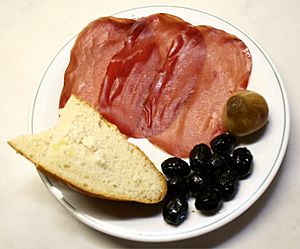
Because of its long history of farming, Lombardy has many types of cold cuts and sausages. Among the protected products, there are three types of pork salami: Brianza salami (from the hills between Lecco and Milan), Varzi salami (from Oltrepò Pavese, made with pork, pepper, and wine), and Cremona salami. A special one is goose salami from Mortara, in Lomellina, where goose meat is very common in cooking.
Every province has at least one typical salami, with famous ones like Milano salami, Casalin mantovano, and bastardei from Valchiavenna. Also from Valtellina are bresaola, which is cured beef that can be smoked, and slinzega.
For hams, there's prosciutto mantovano (sweet), prosciutto crudo delle Orobie, prosciutto al pepe della Valtellina, and prosciutto d'oca stagionato della Lomellina (cured goose ham). Besides mortadella made across the region, there's also Vin Brulé liver mortadella, from the mountains between Lecco and Valtellina.
Bread
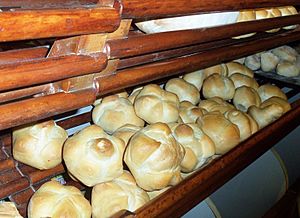
A common bread in Milan and western Lombardy is the rosetta, locally called michetta. It's a hollow bread with a "turtle shell" shape, traditionally eaten with cold cuts, especially mortadella. It used to be a popular, cheap snack for workers.
In Pavia, you'll find hard bread, which takes a long time to prepare, and rice bread, common in Lomellina, where lots of rice is grown. Because maize (corn) is widely grown in the Lombardy plain, you can also find yellow bread made with corn flour in lower Lombardy.
From Valtellina, there's rye bread, a doughnut-shaped bread made with rye flour. From Livigno, there's pan carcent, a doughnut-shaped bread with turnips in the dough, and pan da cool, loaves of bread with colostrum (first milk from a cow) added.
Recently, Garibalda was chosen as Bergamo's typical bread. It's a loaf made from a mix of semolina, whole wheat, buckwheat, and corn flours. From Virgilio, there's pane mantovano or mantovanina, a hard dough bread that forms curls at the ends when baked.
Wine
People have been growing grapes in Lombardy since ancient times. The first reliable records of wine production go back to the first century BC, describing wines from Oltrepò Pavese and the "Rhaetian wines" from the Lake Como area.
Lombardy has 5 DOCG (highest quality), 22 DOC, and 15 IGT (protected regional wines). About 60% of the region's wine production falls under these protected names, which is double the national average.
The most famous wine areas are Oltrepò Pavese (in Pavia province), Franciacorta (a hilly area south of Lake Iseo), the morainic area around Lake Garda, and Valtellina. In Valtellina, wines are grown on special terraces on very steep mountainsides, which helps the grapes get more sun despite the cold climate.
The 5 top-quality (DOCG) wines from Lombardy are:
- Franciacorta: A sparkling wine made from chardonnay and pinot grapes, available in white and rosé.
- Valtellina superiore: Made from Nebbiolo grapes grown on the northern side of Valtellina's terraces. It's a full-bodied wine with a strong taste, good with meat dishes.
- Sforzato di Valtellina: Also made from Nebbiolo grapes, but they are left to dry after harvest to naturally increase their sugar content. This creates a rare, structured dry "passito" wine, great with rich meat dishes like stews.
- Oltrepò Pavese metodo classico: A sparkling wine made with Pinot grapes in Pavia province, in white and rosé versions.
- Moscato di Scanzo: A raisin wine made similarly to Sforzato di Valtellina, from hilly areas with steep slopes. It pairs well with chocolate and cheese and is only produced in Scanzorosciate in Bergamo province.
Famous DOC wines include Buttafuoco, Bonarda, and Sangue di Giuda (a sweet red wine) from Oltrepò Pavese. From Franciacorta, there are Curtefranca and Cellatica. From the Garda area, you'll find Valtenesi, Garda Bresciano, and Lugana. Other wines include Rosso di Valtellina and Lambrusco Mantovano.
Wines from Bergamo province, like Terre del Colleoni and Valcalepio, are also worth mentioning. There are also IGT wines from Terre Lariane (Lecco and Como provinces) and the only DOC wine from Milan province, San Colombano.
In the hills of Brianza, especially near Lecco, many small producers still make popular local wines like Pincianel and Nustranel.
Until the mid-1800s, Alto Milanese was also a wine-growing area, with a history going back to Roman times. Some famous wines from this area included Colli di Sant'Erasmo, Santana, and Clintù.
Olive Oil
Even though Lombardy isn't traditionally known for olive oil, olive trees have been grown on its lakes since the Middle Ages. The large lakes help keep the climate mild, protecting the trees from big temperature changes common elsewhere in the region. Overall, Lombardy has over 1600 hectares of land with olive trees, mostly for oil production.
Lombardy has two protected olive oils:
- Laghi Lombardi DOP Extra Virgin Olive Oil: With two subzones, Lario (from Lake Como) and Sebino (from Lake Iseo).
- Garda DOP Extra Virgin Olive Oil: In its Bresciano subzone.
Both oils are known for their low acidity, delicate flavor, and high quality.
Drinks
Grappa (a strong alcoholic drink made from grape pomace) is widely produced in all wine regions, especially in the province of Brescia and the province of Sondrio. Valchiavenna was once a very famous place for grappa production in Italy.
Local grappa makers from Valchiavenna had to move away when the Simplon tunnel opened, as it changed trade routes. Some of the main grappa-producing families in northern Italy today came from Valchiavenna. Imperial drops, a different herbal drink, are made by monks at the Certosa of Pavia.
For liqueurs, the most famous are Braulio, a Valtellina liqueur made from mountain herbs, amaretto liqueur, made from almonds and herbs with origins in the 16th century, and Fernet Branca, a bitter liqueur still produced in its original factory in Milan. Other liqueurs include Vespetrò from Canzo (with coriander, anise, and orange peel), Ramazzotti bitters (created by a pharmacist in Milan), Acqua di tutto cedro (from Salò), and nocino.
Large companies like the Campari Group (who make Aperol) and Illva of Saronno (who make amaretto) also produce drinks here.
A famous Lombard aperitif is pirlo, which is made with still white wine and Campari. It started in Brescia and is similar to the more well-known spritz from Veneto. Nowadays, people sometimes use Aperol instead of Campari for pirlo because it's less alcoholic. Pirlo is served in a tall, balloon-shaped glass.
More Information


